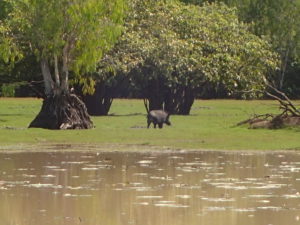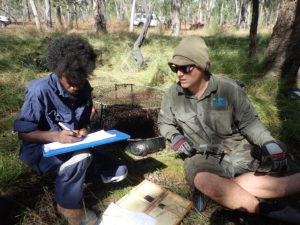Feral pigs and management for wetland protection
Introduction

Feral livestock, particularly pigs, as well as cattle, contribute widespread damage to the landscape, displace native species and threaten agricultural production in northern Australia. Millions of dollars have been and continue to be invested in feral animal management programs. However, these programs are rarely linked to quantified long term outcomes for environmental and cultural asset protection. The damage caused by feral animals is most obvious in wetlands, which hold incredible biodiversity and cultural values. In just a few days, feral pigs can destroy large areas of aquatic vegetation, and in doing so, dramatically impact on water quality and local aquatic species (e.g. freshwater turtles). The solution is to fence entire wetlands, however, explicit data supporting this management intervention is not available.

Working with local indigenous groups and community groups, TropWATER is researching the efficacy of fencing wetlands in terms of improving and protection wetland ecological and cultural values in northern Australia. Data emerging from this research is assisting indigenous groups and landholders to manage landscapes.
Further Reading
Doupé, R.G., Mitchell, J., Knott, M.J., Davis, A.M., Lymbery, A.J., 2010. Efficacy of exclusion fencing to protect ephemeral floodplain lagoon habitats from feral pigs (Sus scrofa). Wetlands Ecology and Management 18, 69-78.
Waltham, N., Schaffer, J., 2016. Baseline aquatic assessment of wetlands identified for feral pig fence exclusion, Archer River catchment. TropWATER James Cook University.
Waltham, N., Schaffer, J., 2017. Continuing aquatic assessment of wetlands with and without feral pig and cattle fence exclusion, Archer River catchment. TropWATER James Cook University, Townsville Australia, p. 44.

